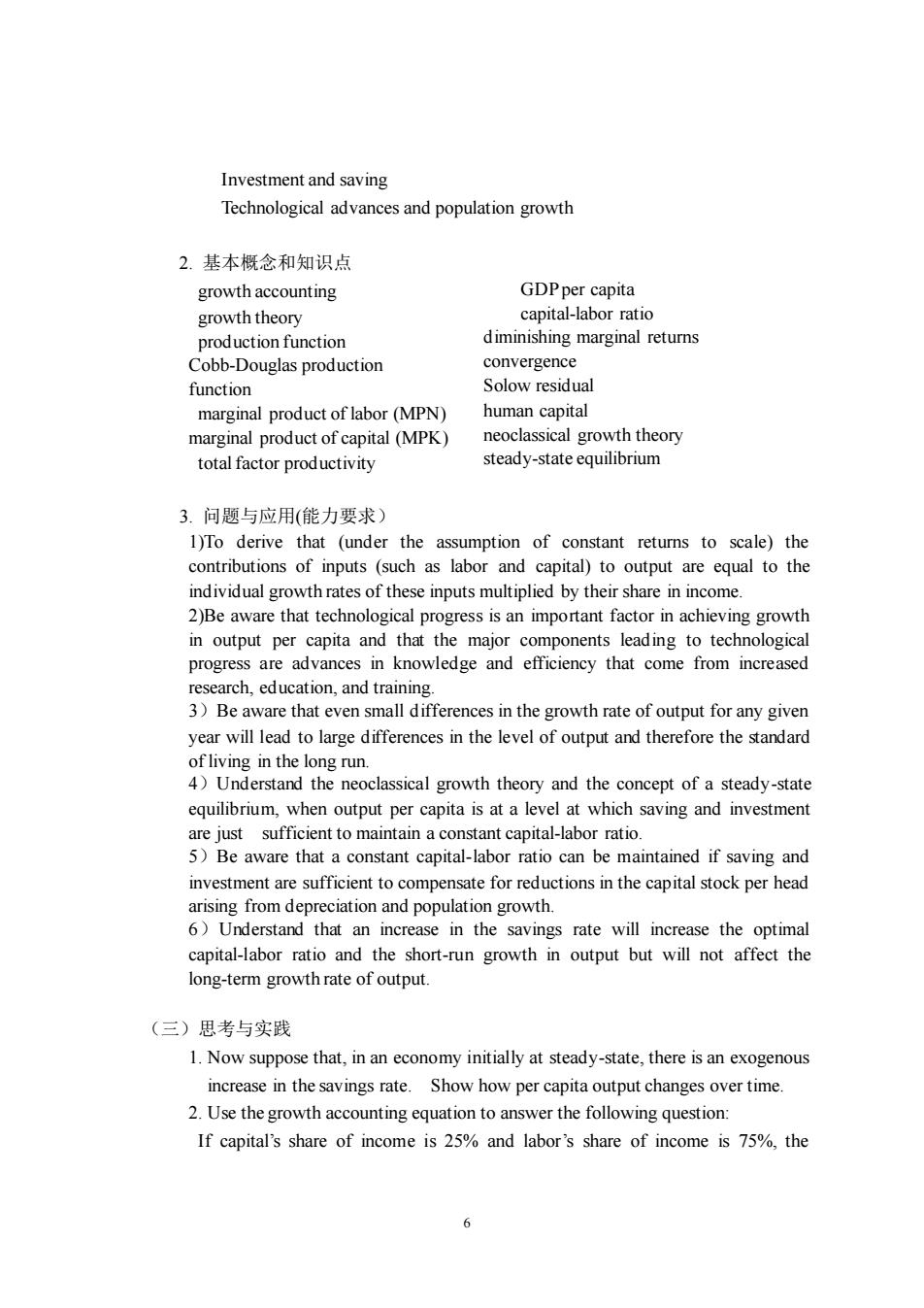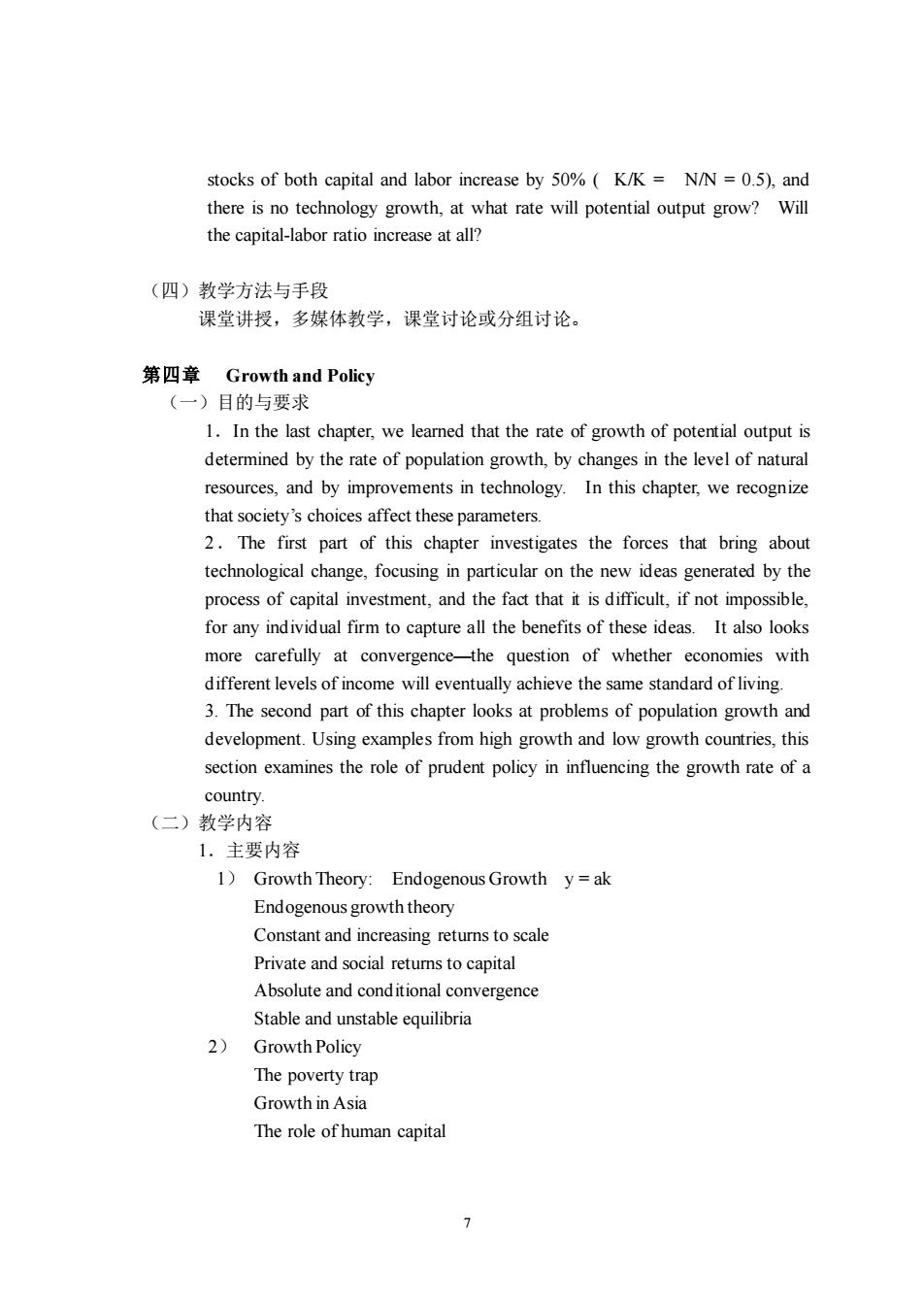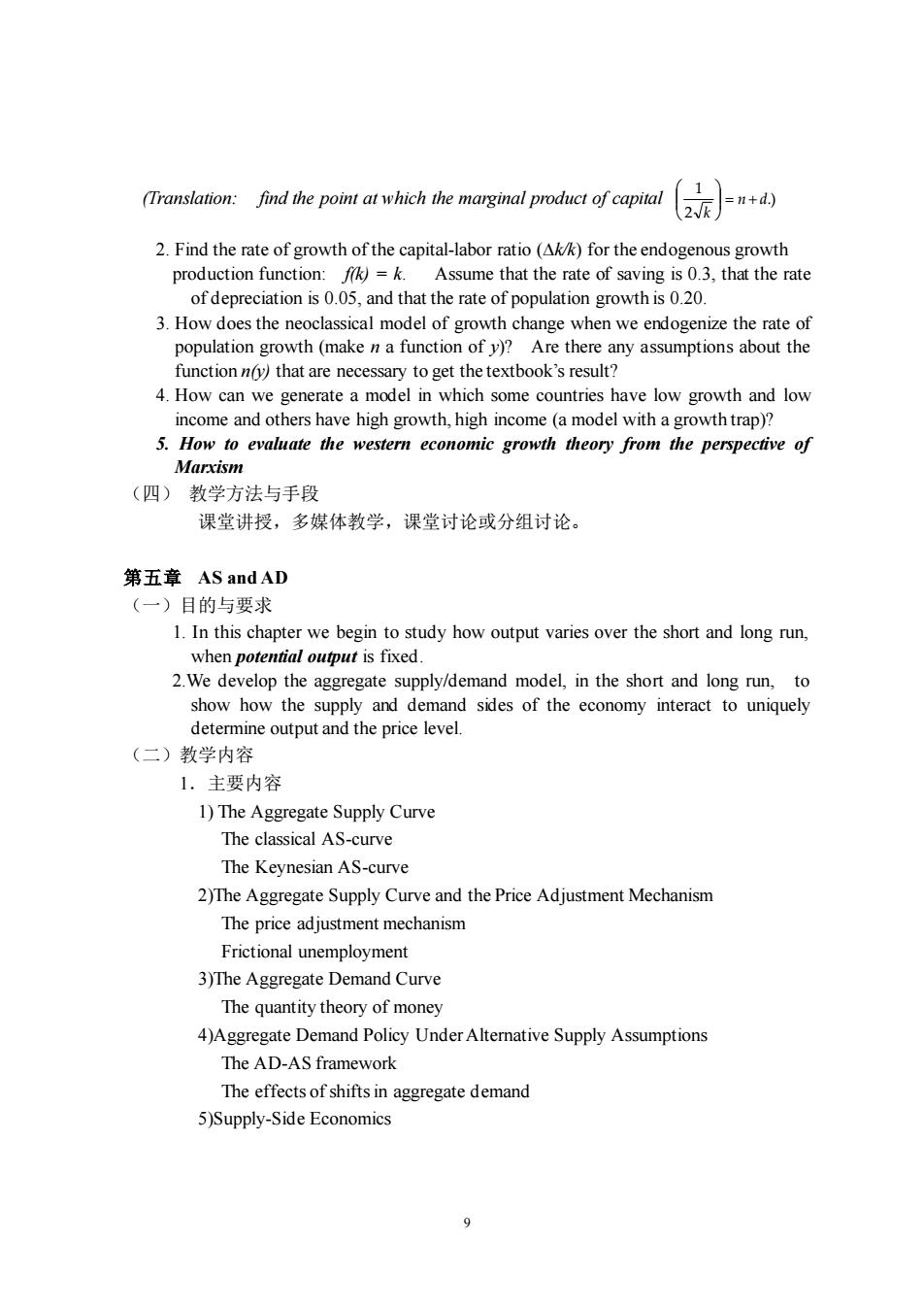
Investment and saving Technological advances and population growth 2.基本概念和知识点 growth accounting GDPper capita growth theory capital-labor ratio production function diminishing marginal retumns Cobb-Douglas production function marginal product of labor (MPN) human capital marg inal product of capital(MPK) neoclassical growth theory total factor productivity steady-state equilibrium 3.问题与应用(能力要求) 1)To derive that (under the assumption of constant retums to scale)the contributions of inputs (such as labor and capital)to output are equal to the individual growth rates of these inputs multiplied by their share in income. 2)Be aware that technological progress is an important facto in achie owth in output per capita and tha th majo onents ad ing to technologic progress are advances in knowledge and efficiency that come from increased research.education,and training. 3)Be aware that even small differences in the growth rate of output for any given year will lead to large differences in the level of output and therefore the standard Understand equilibrium,when output per capita is at a level at which saving and investment are just sufficient to maintain a constant capital-labor ratio. 5)Be aware that a constant capital-labor ratio can be maintained if saving and investment are sufficient to compensate for reductions in the capital stock per head epreciation and populati dthat an inenease in the savings rate will increase the optimal n growth capital-labor ratio and the short-run growth in output but will not affect the long-term growth rate of output (三)思考与实践 1.Now suppose that,in an economy initially at steady-state,there is an exogenous increase in the savings rate.Show how per capita output changes over time 2.Use the growth accounting equation to answer the following question: If capital's share of income is 25%and labor's share of income is 75%,the 6
6 Investment and saving Technological advances and population growth 2. 基本概念和知识点 growth accounting growth theory production function Cobb-Douglas production function marginal product of labor (MPN) marginal product of capital (MPK) total factor productivity GDP per capita capital-labor ratio diminishing marginal returns convergence Solow residual human capital neoclassical growth theory steady-state equilibrium 3. 问题与应用(能力要求) 1)To derive that (under the assumption of constant returns to scale) the contributions of inputs (such as labor and capital) to output are equal to the individual growth rates of these inputs multiplied by their share in income. 2)Be aware that technological progress is an important factor in achieving growth in output per capita and that the major components leading to technological progress are advances in knowledge and efficiency that come from increased research, education, and training. 3)Be aware that even small differences in the growth rate of output for any given year will lead to large differences in the level of output and therefore the standard of living in the long run. 4)Understand the neoclassical growth theory and the concept of a steady-state equilibrium, when output per capita is at a level at which saving and investment are just sufficient to maintain a constant capital-labor ratio. 5)Be aware that a constant capital-labor ratio can be maintained if saving and investment are sufficient to compensate for reductions in the capital stock per head arising from depreciation and population growth. 6)Understand that an increase in the savings rate will increase the optimal capital-labor ratio and the short-run growth in output but will not affect the long-term growth rate of output. (三)思考与实践 1. Now suppose that, in an economy initially at steady-state, there is an exogenous increase in the savings rate. Show how per capita output changes over time. 2. Use the growth accounting equation to answer the following question: If capital’s share of income is 25% and labor’s share of income is 75%, the

stocks of both capital and labor increase by 50%(K/K N/N=0.5),and there is no technology growth,at what rate will potential output grow? Wil the capital-labor ratio increase at all? (四)教学方法与手段 课堂讲授,多媒体教学,课堂讨论或分组讨论。 第四章Growth and Policy (一)目的与要求 1.In the last chapter,we leamed that the rate of growth of potential output is determined by the rate of population growth,by changes in the level of natural resources,and by improvements in technology.In this chapter,we recognize that society's choices affect these parameters 2.The first part of this chapter investigates the forces that bring about technological change,focusing in particular on the new ideas generated by the process of capital investment,and the fact that it is difficult,if not impossible, for any individual firm to capture all the benefits of these ideas.It also looks more carefully at convergence-the question of whether economies with different levels of income will eventually achieve the same standard of living 3.The second part of this chapter looks at problems of population growth and development.Using examples from high growth and low growth countries,this section examines the role of prudent policy in influencing the growth rate of a country. (二)教学内容 1.主要内容 1)Growth Theory:Endogenous Growth y=ak Endogenous growth theory Constant and increasing retums to scale Private and social retums to capital Absolute and conditional convergence Stable and unstable equilibria 2)Growth Policy The poverty trap Growth in Asia The role of human capital
7 stocks of both capital and labor increase by 50% ( K/K = N/N = 0.5), and there is no technology growth, at what rate will potential output grow? Will the capital-labor ratio increase at all? (四)教学方法与手段 课堂讲授,多媒体教学,课堂讨论或分组讨论。 第四章 Growth and Policy (一)目的与要求 1.In the last chapter, we learned that the rate of growth of potential output is determined by the rate of population growth, by changes in the level of natural resources, and by improvements in technology. In this chapter, we recognize that society’s choices affect these parameters. 2.The first part of this chapter investigates the forces that bring about technological change, focusing in particular on the new ideas generated by the process of capital investment, and the fact that it is difficult, if not impossible, for any individual firm to capture all the benefits of these ideas. It also looks more carefully at convergence⎯the question of whether economies with different levels of income will eventually achieve the same standard of living. 3. The second part of this chapter looks at problems of population growth and development. Using examples from high growth and low growth countries, this section examines the role of prudent policy in influencing the growth rate of a country. (二)教学内容 1.主要内容 1) Growth Theory: Endogenous Growth y = ak Endogenous growth theory Constant and increasing returns to scale Private and social returns to capital Absolute and conditional convergence Stable and unstable equilibria 2) Growth Policy The poverty trap Growth in Asia The role of human capital

Limits to growth 2.基本概念和知识点 endogenousgrowth increasing retums to scale absolute convergence conditional convergence stable equilibrium unstable equilibrium golden-rule capital stock 3.问题与应用(能力要求) 1)Students should be able to distinguish between exogenous and endogenous growth. 2)Students should be familiar with the concept of an aggregate production function that displays constant,increasing,or decreasing retums to scale. 3)Students should know that endogenous growth theory can imply that technological progress can be fostered by govemment policies. 4)Students should be aware that technological progress is an important factor in achieving growth in output per capita and that the major components leading to technological progress are advances in knowledge and efficiency that come from increased research,education,and training. 5)Students should be able to distinguish between private and social returns to capital. Students should be aware that,contrary to the prediction of the endogenous growth model,the notion of conditional convergence seems to hold,that is, countries with higher savings rates most often are not able to achieve highe long-term growth rates. 6)Students should be able to evaluate the options available to developing nations for increasing their economic growth rate.This includes the lessons learned from the Asian Tigers as well as strategies to help poor countries escape the poverty trap (三)思考与实践 1.Consider the following neoclassical production function:Y=K a)Write this production function in per capita form b)Find the golden rule level of the (steady-state)capital-labor ratio,when the rat of depreciation is 0.05.and the (exogenous)rate of population growth is 0.20
8 Limits to growth 2. 基本概念和知识点 endogenous growth increasing returns to scale absolute convergence conditional convergence stable equilibrium unstable equilibrium golden-rule capital stock 3. 问题与应用(能力要求) 1)Students should be able to distinguish between exogenous and endogenous growth. 2)Students should be familiar with the concept of an aggregate production function that displays constant, increasing, or decreasing returns to scale. 3)Students should know that endogenous growth theory can imply that technological progress can be fostered by government policies. 4)Students should be aware that technological progress is an important factor in achieving growth in output per capita and that the major components leading to technological progress are advances in knowledge and efficiency that come from increased research, education, and training. 5)Students should be able to distinguish between private and social returns to capital. Students should be aware that, contrary to the prediction of the endogenous growth model, the notion of conditional convergence seems to hold, that is, countries with higher savings rates most often are not able to achieve higher long-term growth rates. 6) Students should be able to evaluate the options available to developing nations for increasing their economic growth rate. This includes the lessons learned from the Asian Tigers as well as strategies to help poor countries escape the poverty trap. (三) 思考与实践 1. Consider the following neoclassical production function: Y = K1/2N1/2 a) Write this production function in per capita form b) Find the golden rule level of the (steady-state) capital-labor ratio, when the rate of depreciation is 0.05, and the (exogenous) rate of population growth is 0.20

Transaon nd the pout c e rnpoct f epual 2.Find the rate of growth of the capital-labor ratio ()for the endogenous growth production function: Assume that the rate of saving is 0.3,that the rate of depreciation is 0.05,and that the rate of population growth is 0.20. 3.How does the neoclassical model of growth change when we endogenize the rate of population growth (makena function ofy)?Are there any assumptions about the toge the textbook's result? 4.How can we generate a model in which some countries have low growth and low income and others have high growth,high income (a model with a growth trap)? 5.How to evaluate the western economic growth theory from the perspective of Marxism (四)教学方法与手段 课堂讲授,多媒体教学,课堂讨论或分组讨论。 第五章AS andAD (一)目的与要求 1.In this chapter we begin to study how output varies over the short and long run, when potential output is fixed. 2.We develop the agg egate supply/demand model,in the short and long run,to now how the supp and sides of the economy interact to uniquely determine output and the price leve (二)教学内容 1.主要内容 1)The Aggregate Supply Curve The classical AS-curve The Keynesian AS-curve 2)The Aggregate Supply Curve and the Price Adjustment Mechanism The price adjustment mechanism Frictional unemployment 3)The Aggregate Demand Curve The quantity theory of money 4)Aggregate Demand Policy UnderAlterative Supply Assumptions The AD-AS framework The effects of shifts in aggregate demand 5)Supply-Side Economics
9 (Translation: find the point at which the marginal product of capital .) 2 1 n d k = + 2. Find the rate of growth of the capital-labor ratio (k/k) for the endogenous growth production function: f(k) = k. Assume that the rate of saving is 0.3, that the rate of depreciation is 0.05, and that the rate of population growth is 0.20. 3. How does the neoclassical model of growth change when we endogenize the rate of population growth (make n a function of y)? Are there any assumptions about the function n(y) that are necessary to get the textbook’s result? 4. How can we generate a model in which some countries have low growth and low income and others have high growth, high income (a model with a growth trap)? 5. How to evaluate the western economic growth theory from the perspective of Marxism (四) 教学方法与手段 课堂讲授,多媒体教学,课堂讨论或分组讨论。 第五章 AS and AD (一)目的与要求 1. In this chapter we begin to study how output varies over the short and long run, when potential output is fixed. 2.We develop the aggregate supply/demand model, in the short and long run, to show how the supply and demand sides of the economy interact to uniquely determine output and the price level. (二)教学内容 1.主要内容 1) The Aggregate Supply Curve The classical AS-curve The Keynesian AS-curve 2)The Aggregate Supply Curve and the Price Adjustment Mechanism The price adjustment mechanism Frictional unemployment 3)The Aggregate Demand Curve The quantity theory of money 4)Aggregate Demand Policy Under Alternative Supply Assumptions The AD-AS framework The effects of shifts in aggregate demand 5)Supply-Side Economics